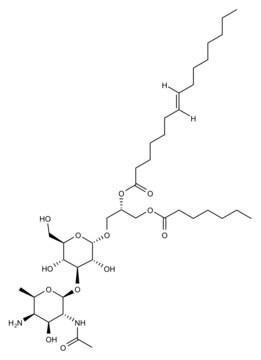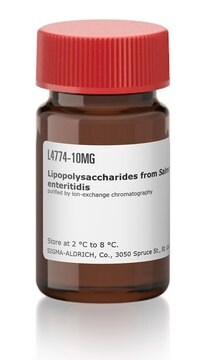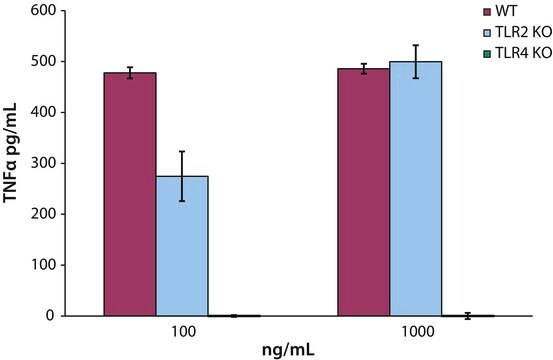L6261
Lipopolysaccharides from Salmonella enterica serotype minnesota
purified by phenol extraction
Sinonimo/i:
LPS
Autenticatiper visualizzare i prezzi riservati alla tua organizzazione & contrattuali
About This Item
Prodotti consigliati
Origine biologica
Salmonella enterica (serotype minnesota)
Livello qualitativo
Stato
lyophilized powder
Purificato mediante
phenol extraction
Impurezze
<3% Protein (Lowry)
Solubilità
water: soluble
Temperatura di conservazione
2-8°C
Cerchi prodotti simili? Visita Guida al confronto tra prodotti
Descrizione generale
Lipopolysaccharide (LPS) is the pyrogenic element arising from enterobacteria such as Escherichia coli and Salmonella enterica. It is an amphiphilic component containing polysaccharides and lipoidic material. LPS is present in the outer membrane of the cell wall of almost all Gram-negative bacteria.
Lipopolysaccharides (LPSs) are characteristic components of the cell wall of Gram-negative bacteria. LPS and its lipid A moiety stimulate cells of the innate immune system by the Toll-like receptor 4 (TLR4), a member of the Toll-like receptor protein family, which recognizes common pathogen-associated molecular-patterns (PAMPs).
Applicazioni
Lipopolysaccharides from Salmonella enterica serotype minnesota has been used:
- as a toll-like receptors (TLR ) agonist to induce tumor necrosis factor (TNF) α production in cereblon and Rabex-5 deficient mice in vivo,
- to study its effect on prostaglandin-E Synthase (PTGES) protein expression in monocyte-derived macrophages
- as a positive control for the maturation of monocyte-derived dendritic cells (MoDCs) to assess secretion of interleukin-10 and interferon (IFN)-γ
- as a supplement in Roswell park memorial institute (RPMI)media for culturing splenic B cells
- as a toll-like receptor 4 ligand to study its effect on the expression of the proallergic cytokines thymic stromal lymphopoietin (TSLP) and interleukin 33 (IL33) in H292 cells (pulmonary mucoepidermoid carcinoma cells)
Azioni biochim/fisiol
Lipopolysaccharide (LPS) forms a permeability barrier around the cell surface to restrict the entry of toxic molecules such as antibiotics and bile salts. Owing to their external location, this endotoxin also plays a vital role in host-bacterium interactions by regulating host immune response. LPS is a microbe-associated molecular pattern (MAMP) that serves as a potent agonist for toll-like receptor 4 (TLR4)-MD2-CD14 receptor complex.
Altre note
To gain a comprehensive understanding of our extensive range of Lipopolysaccharides for your research, we encourage you to visit our Carbohydrates Category page.
Prodotti correlati
N° Catalogo
Descrizione
Determinazione del prezzo
Avvertenze
Danger
Indicazioni di pericolo
Consigli di prudenza
Classi di pericolo
Acute Tox. 2 Oral
Codice della classe di stoccaggio
6.1A - Combustible acute toxic Cat. 1 and 2 / very toxic hazardous materials
Classe di pericolosità dell'acqua (WGK)
WGK 3
Punto d’infiammabilità (°F)
Not applicable
Punto d’infiammabilità (°C)
Not applicable
Scegli una delle versioni più recenti:
Possiedi già questo prodotto?
I documenti relativi ai prodotti acquistati recentemente sono disponibili nell’Archivio dei documenti.
I clienti hanno visto anche
September R Mihaly et al.
PloS one, 9(4), e94982-e94982 (2014-04-17)
Macrophages play diverse roles in tissue homeostasis and immunity, and canonically activated macrophages are critically associated with acute inflammatory responses. It is known that activated macrophages undergo cell death after transient activation in some settings, and the viability of macrophages
Mohammed A Khedr et al.
European journal of gastroenterology & hepatology, 27(10), 1170-1174 (2015-07-07)
Hepatitis C virus (HCV) infection is a major health problem worldwide. Defective dendritic cell (DC) activation of T cells may underlie poor T-cell responsiveness in HCV infection. To evaluate the DCs' functions in chronically infected HCV patients and its correlation
David Millrine et al.
International immunology, 28(6), 307-315 (2016-02-13)
Thalidomide and its derivatives, collectively referred to as immunomodulatory drugs (IMiDs), are effective inhibitors of inflammation and are known to inhibit TLR-induced TNFα production. The identification of Cereblon as the receptor for these compounds has led to a rapid advancement
Blake Bertani et al.
EcoSal Plus, 8(1) (2018-08-02)
The cell envelope is the first line of defense between a bacterium and the world-at-large. Often, the initial steps that determine the outcome of chemical warfare, bacteriophage infections, and battles with other bacteria or the immune system greatly depend on
Christiane Eder et al.
Particle and fibre toxicology, 6, 27-27 (2009-10-20)
Cytochrome P450 monoxygenases play an important role in the defence against inhaled toxic compounds and in metabolizing a wide range of xenobiotics and environmental contaminants. In ambient aerosol the ultrafine particle fraction which penetrates deeply into the lungs is considered
Il team dei nostri ricercatori vanta grande esperienza in tutte le aree della ricerca quali Life Science, scienza dei materiali, sintesi chimica, cromatografia, discipline analitiche, ecc..
Contatta l'Assistenza Tecnica.




